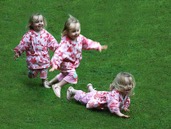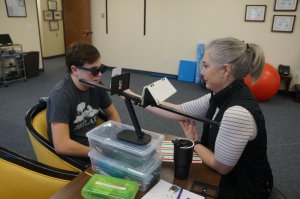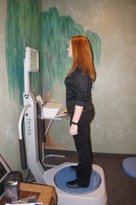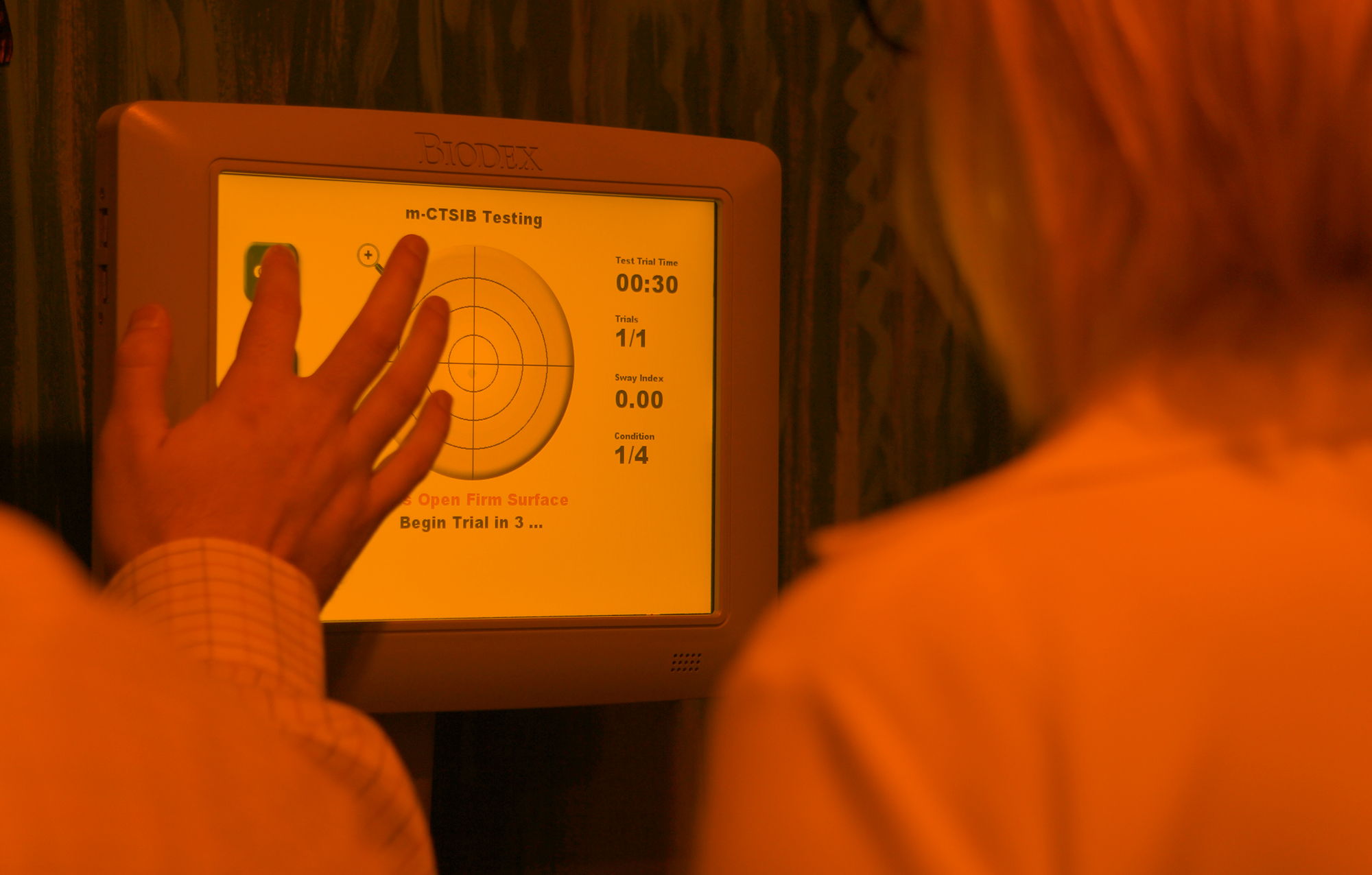Have you ever rolled over in bed and been struck with the room spinning uncomfortably? Or maybe you have experienced standing up too quickly only to feel a bout of lightheadedness along with that uncomfortable unsteadiness on your feet? Or maybe you played a lot of soccer in your youth and headed a few too many soccer balls. Did you know there could be a connection with those persistent headaches and fuzzy thinking that seems to be plaguing you these days and you can actually still do something about it?
Who is at risk?
 Loss of balance and dizziness affect many people in the U.S., many times sneaking up on an individual unexpectedly, impairing quality of life and setting up the affected person for future falls and/or accidents. Before we can talk about how to fix the vestibular system, it is important to appreciate the complexity of this critical system! Basically, while it is the part of the body that controls balance, it doesn’t just work alone! It requires coordination with the eyes, ears, brain and nerves in order to function properly. This includes portions of the inner ear and brain that regulate equilibrium coordinated with eye movements. When something interferes with the way this information is registered or interpreted, symptoms of unsteadiness, dizziness, loss of balance or vertigo may be the result. This condition is more common in adults, but children can also be affected. A report from the National Institute on Deafness and Other Communication Disorders highlighted that more than one out of every 20 children in the U.S. have a vestibular disorder and 15 percent of American adults suffer from dizziness or an imbalance problem associated with some sort of a visual disorder. Vestibular dysfunction also happens to be the leading cause of falls among seniors, contributing to the loss of independence and decreased quality of life as a result.
Loss of balance and dizziness affect many people in the U.S., many times sneaking up on an individual unexpectedly, impairing quality of life and setting up the affected person for future falls and/or accidents. Before we can talk about how to fix the vestibular system, it is important to appreciate the complexity of this critical system! Basically, while it is the part of the body that controls balance, it doesn’t just work alone! It requires coordination with the eyes, ears, brain and nerves in order to function properly. This includes portions of the inner ear and brain that regulate equilibrium coordinated with eye movements. When something interferes with the way this information is registered or interpreted, symptoms of unsteadiness, dizziness, loss of balance or vertigo may be the result. This condition is more common in adults, but children can also be affected. A report from the National Institute on Deafness and Other Communication Disorders highlighted that more than one out of every 20 children in the U.S. have a vestibular disorder and 15 percent of American adults suffer from dizziness or an imbalance problem associated with some sort of a visual disorder. Vestibular dysfunction also happens to be the leading cause of falls among seniors, contributing to the loss of independence and decreased quality of life as a result.
What causes vestibular dysfunction?
 Vestibular dysfunction is often associated with problems in the inner ear which can interfere with a person’s ability to maintain and control their sense of balance. However, it can also be caused by dysfunction anywhere along the vestibular and/or spinal nerve pathways, which contribute to the brain’s interpretation of information about where the body is in space. Sorting out the cause of the dizziness or vertigo is the first step in successful treatment, which must be individualized as a result. Sustaining a concussion is one way to disturb the function of this system for a variety of reasons, but medical conditions can cause problems as well. Conditions like Benign Paroxysmal Positional Vertigo, Meniere’s disease, Mal de Embarque, medication side effects, Labyrinthitis, blood pressure fluctuations, vestibular neuritis and more can all cause balance issues as well.
Vestibular dysfunction is often associated with problems in the inner ear which can interfere with a person’s ability to maintain and control their sense of balance. However, it can also be caused by dysfunction anywhere along the vestibular and/or spinal nerve pathways, which contribute to the brain’s interpretation of information about where the body is in space. Sorting out the cause of the dizziness or vertigo is the first step in successful treatment, which must be individualized as a result. Sustaining a concussion is one way to disturb the function of this system for a variety of reasons, but medical conditions can cause problems as well. Conditions like Benign Paroxysmal Positional Vertigo, Meniere’s disease, Mal de Embarque, medication side effects, Labyrinthitis, blood pressure fluctuations, vestibular neuritis and more can all cause balance issues as well.
So, what is vestibular rehab therapy (VRT)?
 Vestibular rehabilitation focuses on improving the synergy among the inner ear and eyes along with the peripheral and central nervous system. The goal of VRT is to ease both the immediate and long-term problems and symptoms caused by the dysfunction. It is an exercise-based physical therapy program that helps to correct gaze and gait stabilization mechanisms, reducing the dizziness, imbalance and vertigo that can occur as a result. A vestibular therapist is trained in differential diagnoses and is a key player in helping to sort out what may be causing the problem and what is required to fix it. This starts with taking a careful history and putting the patterns together; how long are the dizzy spells? Does movement trigger vertigo? Is it worse in the morning or at night? How long has it been going on? Does it seem like the room is spinning or do you feel lightheaded and about to faint?
Vestibular rehabilitation focuses on improving the synergy among the inner ear and eyes along with the peripheral and central nervous system. The goal of VRT is to ease both the immediate and long-term problems and symptoms caused by the dysfunction. It is an exercise-based physical therapy program that helps to correct gaze and gait stabilization mechanisms, reducing the dizziness, imbalance and vertigo that can occur as a result. A vestibular therapist is trained in differential diagnoses and is a key player in helping to sort out what may be causing the problem and what is required to fix it. This starts with taking a careful history and putting the patterns together; how long are the dizzy spells? Does movement trigger vertigo? Is it worse in the morning or at night? How long has it been going on? Does it seem like the room is spinning or do you feel lightheaded and about to faint?
When a condition like Benign Paroxysmal Positional Vertigo (BPPV) is the case, the vestibular therapist can figure out the exact semicircular ear canal that is causing the problem and perform the specific corrective maneuvers to fix it, often with immediate results. When other signs are present like tinnitus (ringing in the ears) or a pulsing sensation, they may refer you to an ENT or audiologist for more extensive testing and treatment first.
What kind of exercises are involved in vestibular rehab therapy (VRT)?
VRT involves the use of individually prescribed and functional exercises based on the patient’s symptoms. This customized approach includes exercise that involves head movement, gait training and eye exercises designed to improve the patient’s stability, posture and walking. The symptoms experienced during the session will determine the dosage. In order for the treatment to be most effective, you typically need to work into the range of discomfort but recover quickly as soon as you stop and rest. When symptoms continue to heighten or be provoked, it is likely too much and the intensity should be dropped. Other treatments can be paired with vestibular therapy to make the whole process more comfortable. CranioSacral therapy is one of these treatments. When used in conjunction with the vestibular treatment, it can effectively lessen the negative effects sometimes caused by stirring symptoms up and can help to facilitate the process of recovery.
These are the three main types of exercises used in VRT:
 Habituation exercise
Habituation exercise
Habituation exercises are useful in treating symptoms of dizziness produced by self-motion and visual stimuli. These exercises are for patients who experience increased dizziness, especially when making head movements, like looking off to the side while walking down a grocery aisle. Patients who experience dizziness in visually-stimulating environments such as grocery stores, shopping malls, watching television or action movies are candidates for this type of exercise. They do not work for dizziness that comes on suddenly without provocation of movement or visual stimuli.- Gaze stabilization
Gaze stabilization exercises are effective in improving eye movement controls to enhance visual clarity during head movement. These exercises work for patients who experience a ‘bouncing’ appearance of their visual world, especially when trying to focus on an object during movement or when trying to read. - Balance training exercise
Balance training exercises are used to improve postural stability in patients who struggle performing daily activities needed for work, self-care and leisure. The therapist will work closely with the patient to match the postural needs of the individual, creating situations to safely challenge their balance without the risk of falling.
How to treat a concussion with vestibular therapy?
In concussion treatment, identifying the source of the problem remains the most critical step to ensure a successful treatment using vestibular rehabilitation. Trauma due to a fall (at any age) and accidental human collision (like what can occur in sports) are two of the most common causes of concussion. Common symptoms following a concussion that can involve the vestibular system include:
- Dizziness.
- Headache.
- Balance challenges.
- Difficulty concentrating.
- Sleeping disorder.
- Vomiting.
- Blurry vision.
Correct treatment can help to improve all of the above symptoms. The concussion specialist who is a vestibular therapist will check for balance, eye movements, postural strength, gait, mental awareness and positional testing during the assessment. Based on the outcome of the assessment, they will develop a treatment plan to address the symptoms and causes. The goal is to achieve a complete recovery before the individual returns to learn, work or play.
No matter what the cause, vestibular therapy can make all the difference in the quality of your life and achieving a complete recovery! It is worth it to seek out a qualified vestibular specialist in your area and get on the road to recovery!!!


